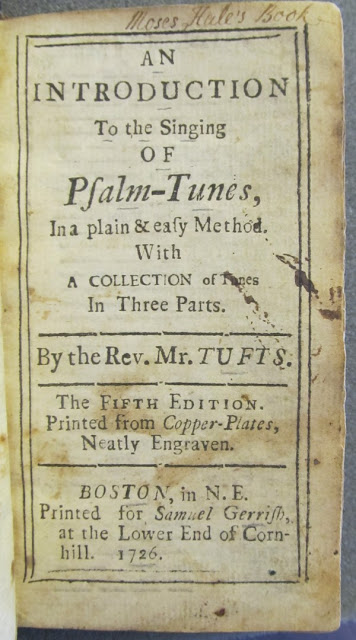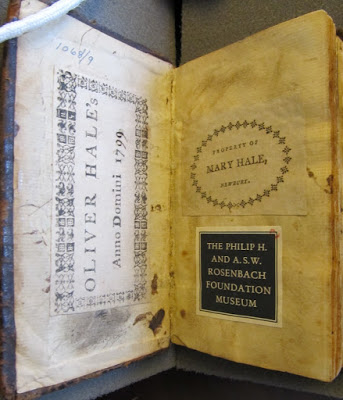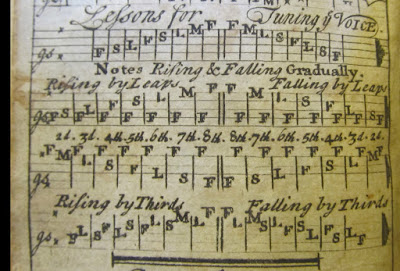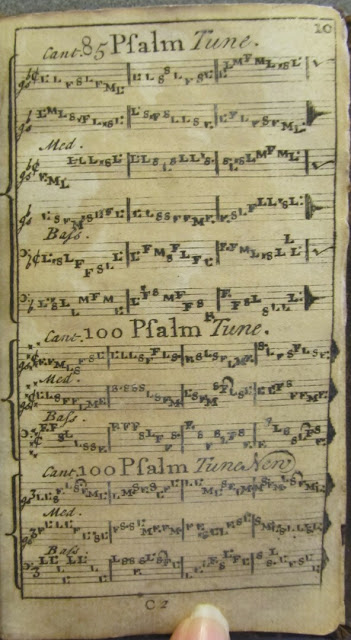When I’m not at the Rosenbach, one of my hobbies is singing with a local chorus here in Philadelphia, so now that December has arrived I am immersed in a non-stop round of rehearsals, concerts, and gigs. Being in a musical frame of mind, this week’s post looks at a 300-year old music book: An Introduction to the Singing of Psalm Tunes, In a Plain & easy method. With a Collection of Tunes in Three Parts, written by the Rev. John Tufts of Newbury, Massachusetts. There seems to be some debate about when the first edition of this book was published, I’ve seen dates from 1710 to 1721. Our 1726 copy is the 5th edition, which is the oldest surviving edition.
 |
| John Tufts, An Introduction to the Singing of Psalm Tunes. Boston: Samuel Gerrish, 1726. Collection of the Rosenbach. A 726i |
An Introduction is a slender book, but our copy was clearly well-loved as it seems to have circulated through three members of the same Newbury family–not only did Moses Hale write his name on the title page, but it also contains bookplates for Oliver and Mary Hale. I especially like Oliver hales bookplate (ont he elft) with its wonderful assortment of printers’ flowers.
 |
| John Tufts, An Introduction to the Singing of Psalm Tunes. Boston: Samuel Gerrish, 1726. Collection of the Rosenbach. A 726i |
The book consists mainly of a compilation of tunes, with a section at the front explaining how to read them. The melodies are written on treble and bass staves, but instead of using conventional musical notes, Tufts uses letters indicating solfege symbols (S for sol; L for la etc.). he only used four solfege syllables: fa, sol, la, mi, with fa being used for the root and 4th; sol for the 2nd and 5th, la for the 3d and 6th and mi for the leading tone 7th. These letters had been used along with more conventional musical notes in the 1698 edition of the Bay Psalm Book, which may have inspired Tufts. For duration Tufts added a dot after the letter if it was to be held for two beats and a colon for four, as shown in his explanatory key below.
 |
| John Tufts, An Introduction to the Singing of Psalm Tunes. Boston: Samuel Gerrish, 1726. Collection of the Rosenbach. A 726i |
One of my favorite bits in the book is that Tufts includes some exercises before diving into the psalm tunes. I was struck by how little has changed–these mental and vocal exercises of going up and down scales and intervals is exactly what I do every Wednesday night during choral warm-ups.
 |
| John Tufts, An Introduction to the Singing of Psalm Tunes. Boston: Samuel Gerrish, 1726. Collection of the Rosenbach. A 726i |
Tuft’s compilation includes 37 three-part hymn tunes. In his 1954 article John Tufts’ “Introduction to the Singing of Psalm-Tunes” (1721-1744): The First American Music Textbook, Irving Lowens compared the tunes against some contemporary hymnals and concluded that “Tufts’ choice of tunes was remarkably astute” since 18 of the 37 were still in modern use. Just for the tunes shown on the page below, you can check out hymnary.org to see hymns that still use the tunes York, St. Mary’s, and Windsor.
 |
| John Tufts, An Introduction to the Singing of Psalm Tunes. Boston: Samuel Gerrish, 1726. Collection of the Rosenbach. A 726i |
Thanks to the Margaret Dodd Singers, the Gregg Smith Singer, and the magic of YouTube, you can also hear some of these tunes used for psalms in an early-American style, although the harmonies may not be exactly those that Tufts provides.
One tune that does not appear in any English publication is “100 Psalm Tune New”, leading Lowens to speculate that it may be an American composition, possibly even by Tufts himself, and as such could be the “earliest authentic specimen of music composed and published in British North America.”
 |
|||
| John Tufts, An Introduction to the Singing of Psalm Tunes. Boston: Samuel Gerrish, 1726. Collection of the Rosenbach. A 726i |
Interestingly, Rev. Tuft’s house, built around 1715, survives in West Newbury and is now on the National Register of Historic Places. So if you’re driving by, wave and hum a psalm tune!
 |
| Picture by Magic Piano. https://commons.wikimedia.org/wiki/File:WestNewburyMA_RevJohnTuftsHouse.jpg |

Kathy Haas is the Associate Curator at the Rosenbach and the primary poster at the Rosen-Blog.
